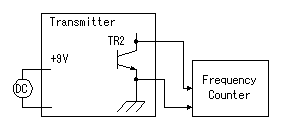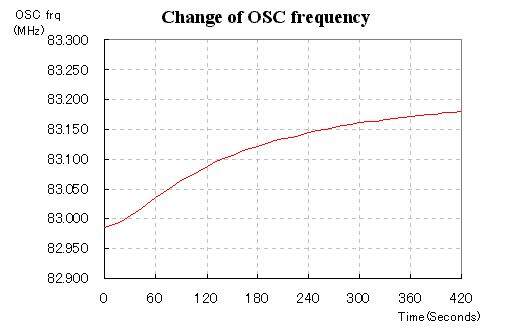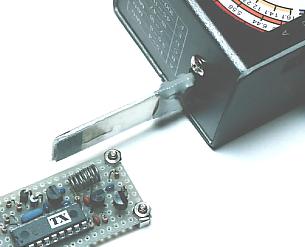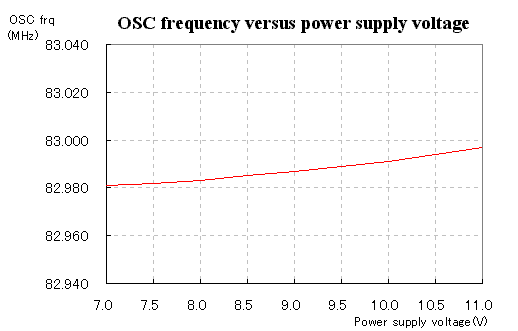 Operation confirmation of the
transmitter Operation confirmation of the
transmitter
It turns on the power of the transmitter without
mounting PIC. Because the base of the oscillation transistor isn't
controlled by PIC when not mounting PIC, it oscillates
continuously.

It connects a frequency counter
with the collector of output transistor (TR2) and it adjusts an
oscillation frequency. A frequency is adjusted by the pitch of the
oscillation coil. I adjusted to the frequency (about 83 MHz) which doesn't
overlap with the FM broadcasting. There is no problem at the other
frequency.
 Measurement of the frequency change Measurement of the frequency change
The frequency stability of the oscillator which was
used this time isn't good. I measured a frequency change from turning on
the power.
 The measurement of the frequency was done for 7 minutes
and the frequency changed from 82.985 MHz to 83.180 MHz. The band is 195
kHz. This measuring time was too long. Actually, the frequency change
immediately after the turning on is important. The receiver should be
controlled by the transmitter. The operation of the transmitter may be
short time. Generally, the receiver can be controlled below 10 seconds.
The frequency change in 10 seconds was to 4 kHz be. This frequency
change seems to be cause for the change of the capacitance of the
transistor by the heat which is caused by the electric current of the
transistor. This frequency change is related with the receiving
sensitivity with receiver. In case of being the receiver which can not
do receiving in the 4-kHz frequency change, it is a problem. Generally,
even if it shifts by 4 kHz, there is no problem. However, when the
electric wave is weak, the influence sometimes comes out.
 Measurement of the frequency change by the power
supply voltage Measurement of the frequency change by the power
supply voltage
The power of the transmitter is a dry battery. So, the
dry battery consumes when using long and the power supply voltage falls.
I changed a power supply voltage and measured a frequency change. The
oscillation frequency changes when making do the operation of the
transmitter. Therefore, I measured a frequency after stopping a
transmitter after setting voltage and keeping time for a
while.
The frequency change when changing power supply voltage
from 7V to 11V was to 16kHz be. This is not a big change. It seems that
it does the operation even if the dry battery weakens.
 Confirmation of the oscillation frequency by the
dip meter Confirmation of the oscillation frequency by the
dip meter

I recognize the
oscillation frequency of the transmitter by the frequency counter.
Moreover, I checked a frequency with dip meter.
I will
use a dip meter for the frequency adjustment for the receiver. So, this
measurement is the operation confirmation of the dip meter.
|



